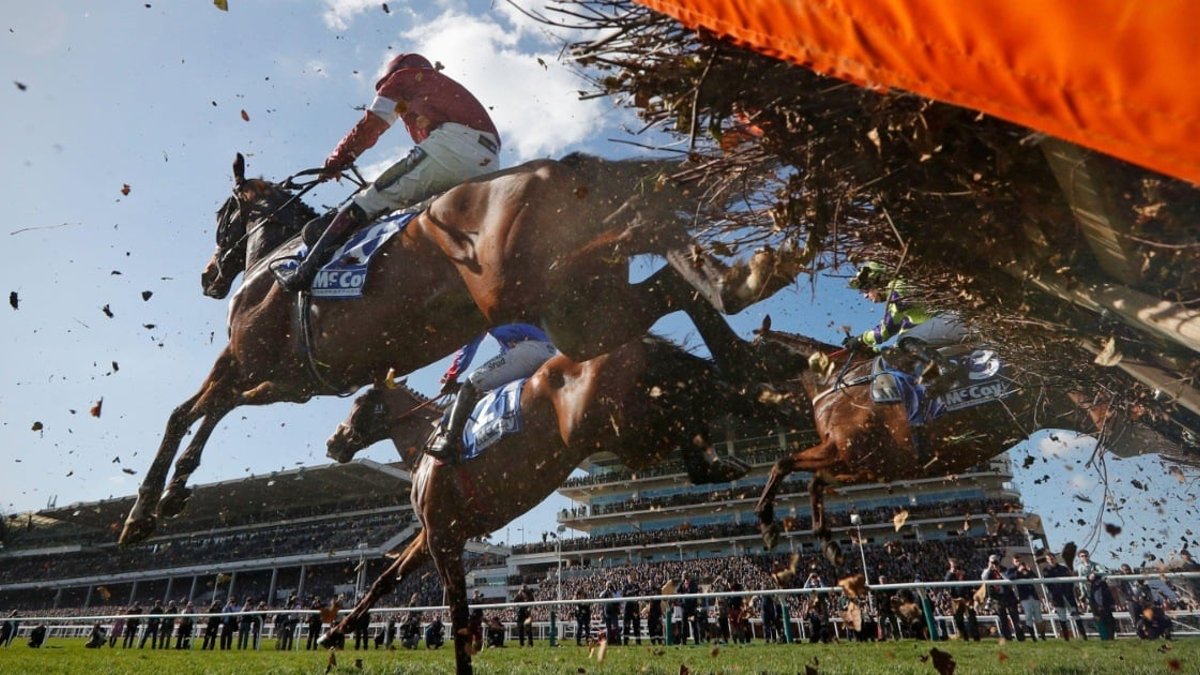Horse Racing Terms Explained: A-Z Glossary For Racing Punters

If you are new to the sport of horse racing and unsure what many horse racing terms mean, we have you covered.
Racing really has a whole language of its own, so learning horse racing betting terms will help you to understand how the sport functions.
Arranged in alphabetical order, this glossary of horse racing terms should enable any novice to build a better understanding of the sport, which will hopefully help you beat the bookies more often in the long-run.
As always, it's important to compare the best horse racing odds today before filling out your betslip.
Abandoned
A race meeting can be abandoned, normally because of adverse weather conditions. All bets placed on abandoned races are fully refunded.
If an abandoned meeting contains high-profile races, those will often be rescheduled to take place at another meeting.
All Weather
All-weather racing takes place on an artificial racing surface.
There are currently six all-weather tracks in Britain and Ireland, all of which use either a Polytrack or Tapeta surface: Lingfield (P), Kempton (P), Southwell (T), Chelmsford (P), Newcastle (T) and Dundalk (P).
Allowance
Weight allowances depend on the conditions of a race. The gender and age of a horse are the two most common reasons for allowances, especially in stakes races.
The younger a horse, the bigger the allowance he or she will be entitled to from older rivals, while female horses get an allowance from their male counterparts. In jumps racing, this allowance is 7lb.
Also-Ran
Also-ran refers to horses that finished out of the designated number of places for a race. So, in a 10-runner race, also-rans are any horses that finish fourth or worse, including non-finishers.
Ante-Post
An ante-post bet is placed before final declarations for a race are confirmed and can begin months in advance.
Ante-post betting is at its most popular for big meetings like the Cheltenham Festival, where Cheltenham odds for the following year’s championship races are available almost immediately the runners have crossed the line.
Apprentice
An Apprentice or Conditional Jockey’s licence allows riders aged between 16 and 26, who are in full-time paid employment with a UK-based licensed racehorse trainer, to ride with a weight allowance to compensate for their inexperience.
Banker
A ‘banker’ is a horse that is presumed to win. In placepot wagers, anyone that selects multiple horses per race but just a single runner in one or more races, will see those single runner selections as a banker. They need to win, otherwise the bet is down.
Best Odds Guaranteed
A popular promo with fans of the best Cheltenham and Grand National betting offers.
If you place a bet that has best odds guaranteed attached to it, and the SP is greater than the price you took, then your bet will be settled at the bigger odds if it wins.
Betting Ring
The area on a racecourse, normally in front of the main grandstand, where bookmakers stand to take bets.
Bit
The bit is an item of a horse's tack. It usually refers to the assembly of components that contacts and controls the horse's mouth.
Blinkers
Blinkers are applied to a horse in order to shut off the peripheral vision, so that they can only look forward. This means they can concentrate more on what is in front of them and the job in hand.
Bloodstock
Bloodstock refers to horses that have been specially bred for racing. Every thoroughbred racehorse can be traced back to just three stallions, who are responsible for the foundation of the entire breed.
These are The Godolphin Arabian, The Byerley Turk, and The Darley Arabian.
Boxed-In
This simply means that a horse is unable to improve his position because it is surrounded by other horses and cannot get out.
Bridle
A bridle is the collection of leather straps that fit around a horse's head ,connecting the mouth bit and the reins so a jockey can control their mount.
The term 'on the bridle' is used a lot in racing, and it means that the horse in question is travelling sufficiently well that he/she doesn’t require the jockey to push from the saddle to ask for extra effort.
Broodmare
A broodmare is a female horse kept at stud for breeding purposes. Often, they will have raced when they were younger and their performance levels on the track will be reflected in the quality of their offspring.
Bumper
A bumper is a Flat race run under the rules of a Jumps race. Bumpers help horses who have not previously run on the Flat to get experience of this type of racing.
Horses who have previously raced in Flat races are not eligible to run in bumpers. Bumpers are often the last race on a card.
Chase
These are steeplechase races in which runners must jump fences. Steeplechases are run over distances that range between 2 and 4½ miles, and runners jump over a variety of obstacles that include plain fences, water jumps or open ditches.
Checked
Checked is an in-running term used when a horse has had its passage momentarily blocked or hindered.
Cheekpieces
Cheekpieces are soft lengths of sheepskin that attach to the bridle and run down either side of the horse’s head. Their purpose is to encourage the horse to drop its head and not race freely.
Classic
The Classics are regarded as the crown jewels of Flat racing. There are five English Classics: 2,000 Guineas, 1,000 Guineas, Derby, Oaks and St Leger.
They are contested by three-year-olds only and winners of these races are regarded as highly valuable breeding prospects.
Colt
A colt is a male horse aged below five, which has not been gelded.
Course & Distance
Course and Distance is normally used to reference a horse that has winning form, or good form, over the same track and trip that it is about to run over.
Dam
Dam is the equine term for mother.
Dead Heat
Two or more horses cross the finishing line together and cannot be separated by the judge.
Declarations
There are various declaration stages to a horse race, but final declarations are published around 11am the day before a Flat race and two days before a Jumps race.
Declared
Declared means confirmed as a runner.
Drifter
A drifter is a betting term that references a horse whose odds are increasing (meaning chances of winning are theoretically decreasing).
Each Way
An each-way bet is a two-part bet on a horse to win and be placed.
If the horse wins, you will be paid out on both sides of the bet. If it finishes in the designated places, you will only be paid out for the placed part of the wager, usually at 1/4 or 1/5 of the win odds.
Favourite
The favourite is the shortest-priced runner in the field. Theoretically this means the horse has the greatest chance of winning.
Fences
Fences are the obstacles each horse must negotiate in a steeplechase.
Filly
A filly is a female horse aged below five. Once a filly turns five, she becomes a mare.
Foal
A foal is a young horse who hasn’t reached their first birthday.
Form
Form is the back catalogue of a horse’s racing career. Our guide explaining how to read horse racing form should help you learn how to analyse past performance.
Furlong
A furlong is a distance of 220 yards (201 metres). There are eight furlongs in a mile.
Gelding
A gelding is a male horse that has been gelded (castrated).
Going
This refers to the nature of ground conditions at a course. Going conditions range from heavy to firm. For all-weather tracks, the going is normally described as ‘Standard’.
Graded Race
Graded races range from 1-3 (one being the pinnacle) and are the highest-grade races in the sport. They are referred to as ‘Group races’ in British racing.
Handicap
A handicap is a race in which the weight a horse carries is determined by its official rating. So, a horse rated 82 would carry 2lb more than a horse rated 80.
Handicap Rating
A horse’s handicap rating determines what grade of race it is eligible to run in and how much weight it will carry in handicap races.
Handicapper
A handicapper determines the handicap rating of each horse.
Head
A head is a margin of victory where the winner scores by the length of its head from the runner-up.
Hood
A hood covers the horse’s ears and head, leaving eye-holes for them to see through. It helps horses who may be nervous of crowds and noises.
Hunter Chase
Hunter chases take place at National Hunt racecourses but are only open to horses that have hunter certificates.
Hurdler
A hurdler is a horse whose main vocation is hurdle races.
Hurdles
Hurdles are the obstacles used in hurdle races. They are smaller than fences and often used as a stepping stone for horses bred to jump fences in time.
Juvenile
A juvenile is a two-year-old in Flat racing and a three-year-old in National Hunt (Jumps) racing.
Length
A length is the length of a horse, from nose to tail.
Listed Race
Listed races are a stepping stone between handicap races and pattern races, which are Group/Graded races.
Maiden
A maiden is a horse who has not won a race, or a type of race restricted to horses that have not previously won.
Mare
A mare is a female horse aged five or older.
NAP
A NAP is the best bet of the day.
National Hunt
National Hunt is the official name for Jumps racing. If a horse is referred to as National Hunt-bred, then it is bred to jump fences.
Neck
A winning distance that indicates a margin of victory/defeat from the nose to bottom of a horse’s neck.
Non-Runner
A non-runner denotes a horse who was withdrawn from a race after the final declaration stage. Changing ground conditions are one of the primary reasons why a horse would be declared but then withdrawn.
Non-Runner No Bet
NRNB is an ante-post betting special offered by the best horse racing betting sites, meaning your stake is refunded if your selection is not declared at the final declaration stage.
Nose
A nose is the shortest margin of victory in a race. We are talking a few centimetres.
Noseband
A noseband is a piece of equipment that is used to stabilize the bit, so it remains straight and quiet in the mouth. Nosebands also allow horses to relax and settle their tongues, enabling them to breathe better.
Novice
A novice in National Hunt horse racing is a horse which has not won in a particular type of race prior to the start of the current season.
So, a horse that won a novice hurdle last season wouldn’t be eligible for such an event the following season.
In Flat racing, a horse can’t have run or won more than two races to contest a novice event.
Nursery
A nursery is a handicap race for juveniles (two-year-olds) in the Flat sphere.
On The Bit
This is a term sometimes used in reference to a horse whose rider has not had to ask his horse for any effort in the run.
Pacemaker
A pacemaker is a horse that ensures a race is evenly-run, often to the benefit of a better-fancied stablemate.
Paddock
The paddock is an area at a racetrack in which runners parade for the benefit of the racegoers. It is also the area in which most horses are mounted by their jockey (some horses are given permission to be mounted on track).
Pari-Mutuel
Pari-mutuel betting, which is popular in large racing jurisdictions around the world, is a pool-based betting facility that works in the same way as the British Tote.
Payouts are determined by volume staked on each horse and then dividends are issued after the operator's commission and tax.
Penalty
A penalty is an amount of extra weight a horse must carry having won a race previously. Penalty information is always set out in the race conditions.
Placed
Places vary depending on the number of runners and type of contest but generally a horse is deemed to have ‘placed’ if it finishes second or third.
In big-field handicaps such as the Grand National, place terms extend to 5/6 runners with many bookmakers.
Placepot
A placepot is a popular Tote bet that requires you to choose a horse to place in each of the first six races at a race meeting. It’s a bet that can yield big dividends, especially if there are some unplaced favourites.
Pulled-Up
If a horse is pulled-up, it means they have failed to complete the race and are therefore settled as a loser by bookmakers.
Racecard
A racecard is similar to a matchday program at a football match and can also be viewed online.
It provides a detailed layout of each race, with the colours of each runner along with various information such as race conditions, ratings and form.
Racecards will normally carry a synopsis of each race with a verdict at the bottom.
Ran Out
This means that a horse has run off the course and is therefore out of the race.
Refused to Race
Refused to race is a term for horses that line up, or go into the stalls, but then don’t jump off with the rest of the field.
If the horse is deemed to have come ‘Under Starter’s Orders’ then backers of that horse will not be entitled to a refund.
Rule 4
A Rule 4 is a deduction from winning bets in a race where a horse was withdrawn after bets were placed, in theory making the race easier to win. The shorter the odds of the withdrawn horse (at time of withdrawal), the bigger the Rule 4 deduction.
Silks
Silks are worn by the jockeys, the colour and pattern of which is unique to the owner of the horse. If an owner has more than one runner in a race, then they are differentiated by alternative cap colours.
Sprinter
A horse that runs in sprint races, which are run over five or six furlongs.
Stallion
A stallion is an uncastrated male horse who is purposely being used to breed. Any colt that wins at the top level on the Flat will have stallion potential.
Starting Price
The odds of a horse at the off. This is denoted as the SP and any bets placed that have not taken a price will be settled at SP.
Steeplechaser
A horse that predominantly runs in chases.
Steward’s Inquiry
A Steward's enquiry is a review system that takes place after a race to ensure it has been run fairly and rules haven't been broken.
Stewards will watch replays from several angles as well as listen to testimonies from the riders involved, before deciding whether to let the result stand or amend the result.
Stud
A stud is home to a stallion or stallions, where they breed what connections hope are the next generation of champions.
Thoroughbred
A thoroughbred is a horse bred for racing and one whose roots can be traced back to one of the three foundation sires.
Tongue-Tie
A tongue-tie is a piece of equipment used to prevent a horse’s tongue going over the bit, which would make it very difficult to control.
A tongue-tie is usually a strip of cloth or rubber, passed through the mouth and tied below the chin.
Top Weight
This is the horse carrying the most weight in a field. In handicaps, this will always be number 1 on the racecard.
Tote
The Tote provides pool betting services for horse racing.
There are Tote counters at every British racecourse. Payouts are determined by the volume of money staked on each horse.
Triple Crown
The Triple Crown in American horse racing is a prestigious achievement comprising victories in the Kentucky Derby, Preakness Stakes, and Belmont Stakes.
In Britain, the Triple Crown refers to three major flat races - the 2,000 Guineas Stakes, the Epsom Derby, and the St Leger Stakes, showcasing the versatility of three-year-old thoroughbreds across varied distances and courses.
Under Starter’s Orders
Under starter's orders means that a horse has either lined up in the case of a Jumps race or gone into the stalls on the Flat.
If the horse, under either code, fails to jump off from that point, then it is deemed to be under starter’s orders and a runner.
This means that if a horse doesn’t come out of the stalls or doesn’t jump off, backers will not be entitled to a refund.
Unseated
Unseated is the formbook term for a jockey falling off a horse even though the horse didn’t fall itself.
Visor
Visors are very similar to blinkers, but they have a slit cut in the side of them, preventing a horse from panicking if it can't see the other runners.
The slit provides the reassurance that there are other runners but maintains the focus of going forward.
Whip
A whip is used by jockeys to help a horse focus and produce its best in the finish of a race.
Use of the whip, which is foam padded, is limited to six times in a Flat race and seven times in a Jump race, so as not to compromise the welfare of the horse.
Yearling
A horse aged between 1-2.
Stay In The Loop With Free Bets, Insider Tips & More!
Live Betting. Sports Promos. Sent Weekly.













